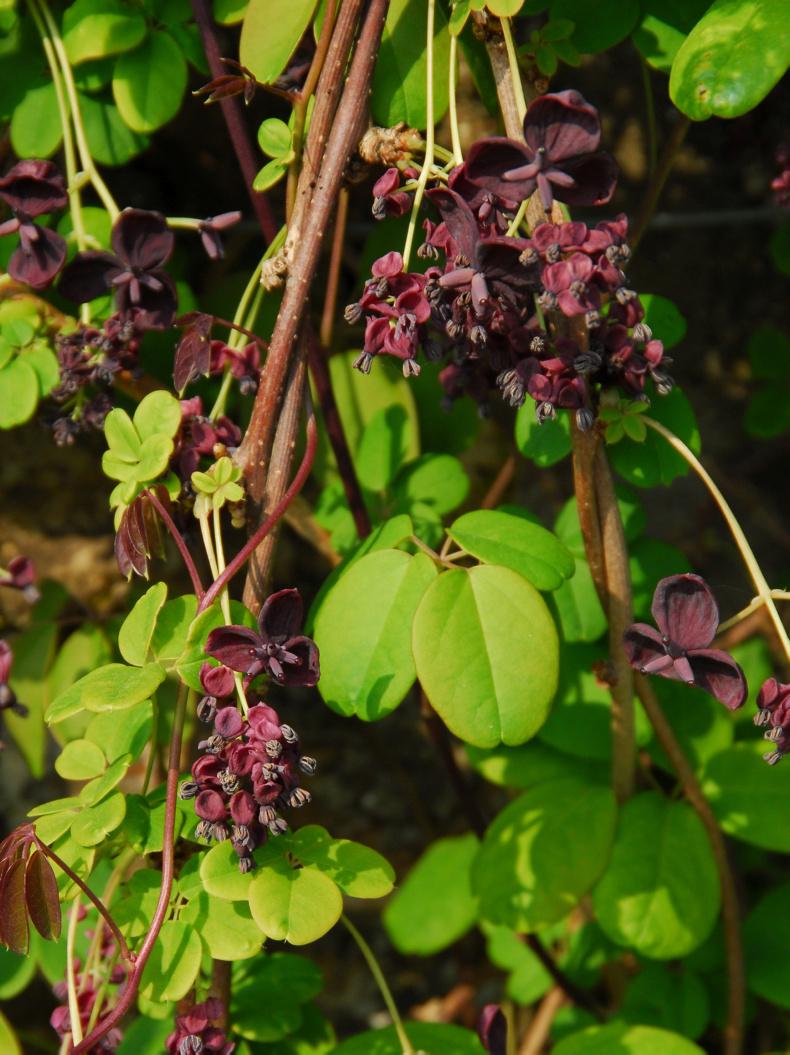The chocolate vine gets its attractive name from its dark, red-brown and purple-wine flowers, but otherwise there is no connection with chocolate and it doesn’t even have a chocolate scent from the open flowers.
Instead, on a warm day its flowers are scented of vanilla, or are sometimes described as spicy.
It flowers in April, the flowers dangling from the slender twining twigs, and it can be difficult to get the scent if the spring weather is cool or blustery.
Given the right soil, well-drained and fertile, the chocolate vine, or akebia quinata, can grow very rapidly and produces a fine show of light green foliage. This is carried on the new shoots, which start to grow in spring and fill out fully in summer.
Scrambling vine
It is a true scrambling vine and its stems have a twining nature, quite slender, and need no tying-in or training, but they do need support of a trellis, wires, a fence, or can be allowed to scramble over fairly robust trees and shrubs.
It can be a bit too energetic for smaller plants and it is too competitive to be planted to ramble through other climbers. It can grow to 10m wide and 5m tall or more in ideal conditions, but usually less.
It is native to China and Japan and gets its name akebia from the Japanese word akebi. It is grown as a fruit in Japan, forming short sausage-shaped fruits, but these rarely form in this cooler climate. Fruit set is more likely if there is more than one plant, as there may be some level of self-sterility in the plants. T
he fruit centre is a white pulp, sweet and edible, though considered insipid. If any fruit is produced it would be a bonus. In any case, the climber is principally grown for its decorative qualities.
Species
There are two species, the deciduous akebia trifoliata, the second part of the name indicating it has leaves divided into three leaflets, and the much more commonly grown, partially evergreen akebia quinata, the species name meaning its leaves are divided into five leaflets.
The leaves are of a pretty light green in spring and early summer, darkening to mid-green later, but at all times airy and decorative.
The flowers are hardly noticeable until up close to them and they are most unusual. There are separate male and female flowers.
This is not unusual as other trees and plants have separate male and female flowers, but the chocolate vine has separate male and female flowers in the same flower cluster.
The female flowers are larger and held above the male flowers, which shed pollen. Usually there are two to four female flowers and four to 15 small males.
Akebia quinata is semi-evergreen, the handsome five-part leaves hanging on in a mild winter and in mild areas, and being shed if the weather is very cold with drying winds.
The plant itself is very hardy, when established, but occasionally die-back may occur if the soil is too heavy and wet in winter.
A late and severe spring frost in April can catch the flowers that are open, but usually there are some more to open if the first ones are lost.
It is not choosy about limy or acidic soil, growing well in either, but it does like humus in the soil. It is a useful, unusual climber because of its winter greenery and its fragrant flowers in late spring and early summer.
Read more
Gardening jobs to do this week
Gardening: Chocolate vine
The chocolate vine gets its attractive name from its dark, red-brown and purple-wine flowers, but otherwise there is no connection with chocolate and it doesn’t even have a chocolate scent from the open flowers.
Instead, on a warm day its flowers are scented of vanilla, or are sometimes described as spicy.
It flowers in April, the flowers dangling from the slender twining twigs, and it can be difficult to get the scent if the spring weather is cool or blustery.
Given the right soil, well-drained and fertile, the chocolate vine, or akebia quinata, can grow very rapidly and produces a fine show of light green foliage. This is carried on the new shoots, which start to grow in spring and fill out fully in summer.
Scrambling vine
It is a true scrambling vine and its stems have a twining nature, quite slender, and need no tying-in or training, but they do need support of a trellis, wires, a fence, or can be allowed to scramble over fairly robust trees and shrubs.
It can be a bit too energetic for smaller plants and it is too competitive to be planted to ramble through other climbers. It can grow to 10m wide and 5m tall or more in ideal conditions, but usually less.
It is native to China and Japan and gets its name akebia from the Japanese word akebi. It is grown as a fruit in Japan, forming short sausage-shaped fruits, but these rarely form in this cooler climate. Fruit set is more likely if there is more than one plant, as there may be some level of self-sterility in the plants. T
he fruit centre is a white pulp, sweet and edible, though considered insipid. If any fruit is produced it would be a bonus. In any case, the climber is principally grown for its decorative qualities.
Species
There are two species, the deciduous akebia trifoliata, the second part of the name indicating it has leaves divided into three leaflets, and the much more commonly grown, partially evergreen akebia quinata, the species name meaning its leaves are divided into five leaflets.
The leaves are of a pretty light green in spring and early summer, darkening to mid-green later, but at all times airy and decorative.
The flowers are hardly noticeable until up close to them and they are most unusual. There are separate male and female flowers.
This is not unusual as other trees and plants have separate male and female flowers, but the chocolate vine has separate male and female flowers in the same flower cluster.
The female flowers are larger and held above the male flowers, which shed pollen. Usually there are two to four female flowers and four to 15 small males.
Akebia quinata is semi-evergreen, the handsome five-part leaves hanging on in a mild winter and in mild areas, and being shed if the weather is very cold with drying winds.
The plant itself is very hardy, when established, but occasionally die-back may occur if the soil is too heavy and wet in winter.
A late and severe spring frost in April can catch the flowers that are open, but usually there are some more to open if the first ones are lost.
It is not choosy about limy or acidic soil, growing well in either, but it does like humus in the soil. It is a useful, unusual climber because of its winter greenery and its fragrant flowers in late spring and early summer.
Read more
Gardening jobs to do this week
Gardening: Chocolate vine









SHARING OPTIONS